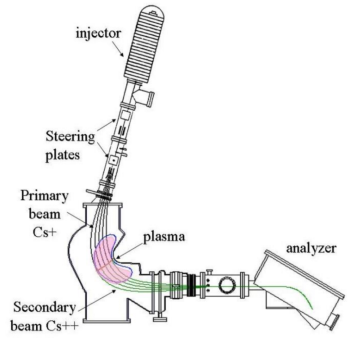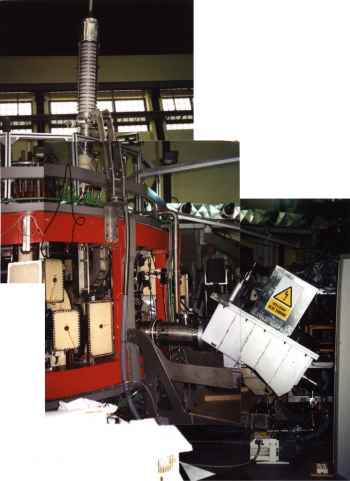TJ-II:Heavy Ion Beam Probe: Difference between revisions
Jump to navigation
Jump to search
No edit summary |
No edit summary |
||
| Line 11: | Line 11: | ||
A multiple cell array detector (MCAD) has been developed to investigate the spatial structure of plasma turbulence. | A multiple cell array detector (MCAD) has been developed to investigate the spatial structure of plasma turbulence. | ||
<ref>[http://link.aip.org/link/?RSINAK/75/3511/1 B. Gonçalves et al, ''Operation of a multiple cell array detector in plasma experiments with a heavy ion beam diagnostic'', Rev. Sci. Instrum. '''75''' (2004) 3511]</ref> | <ref>[http://link.aip.org/link/?RSINAK/75/3511/1 B. Gonçalves et al, ''Operation of a multiple cell array detector in plasma experiments with a heavy ion beam diagnostic'', Rev. Sci. Instrum. '''75''' (2004) 3511]</ref> | ||
The system is located in [[TJ-II:Sectors|sector]] B4. | |||
[[File:TJ-II_HIBP.png|350px|thumb|left|HIBP probe composite photo (taken around 2002)]] | [[File:TJ-II_HIBP.png|350px|thumb|left|HIBP probe composite photo (taken around 2002)]] | ||
== References == | == References == | ||
<references /> | <references /> | ||
Revision as of 19:10, 3 November 2009
At TJ-II, the advanced Heavy Ion Beam Probe can simultaneously measure the plasma electric potential φ, the electron density ne, the electron temperature Te, and a poloidal magnetic field component Bp at a point inside the plasma. [1] [2] [3] [4] [5] [6] This point can be scanned through the plasma cross-section by varying the deflection potentials (active beam control). A multiple cell array detector (MCAD) has been developed to investigate the spatial structure of plasma turbulence. [7] The system is located in sector B4.
References
- ↑ I.S. Bondarenko et al., Installation of an advanced heavy ion beam diagnostic on the TJ-II stellarator, Rev. Sci. Instrum. 72, 583 (2001)
- ↑ L.I. Krupnik et al., The first operation of the advanced heavy ion beam probing diagnostic on the TJ-II flexible heliac, Fusion Engineering and Design 56-57 (2001) 935
- ↑ I.S. Bondarenko et al, High intensity alkali ion sources for plasma diagnostics, Rev. Sci. Instrum. 75 (2004) 1826
- ↑ L. Krupnik et al, Radial electric fields and confinement in the TJ-II stellarator, Czechoslovak Journal of Physics 55, 3 (2005) 317-339(23)
- ↑ L. Pereira et al, Control and data acquisition system for the multiple cell array detector of the TJ-II heavy ion beam diagnostic, Fusion Engineering and Design 81, Issues 15-17 (2006) 1885-1889
- ↑ A.V. Melnikov et al, Plasma Potential Evolution Study by HIBP Diagnostic During NBI Experiments in the TJ-II Stellarator, Fusion Science and Technology 51, 1 (2007) 31-37
- ↑ B. Gonçalves et al, Operation of a multiple cell array detector in plasma experiments with a heavy ion beam diagnostic, Rev. Sci. Instrum. 75 (2004) 3511

